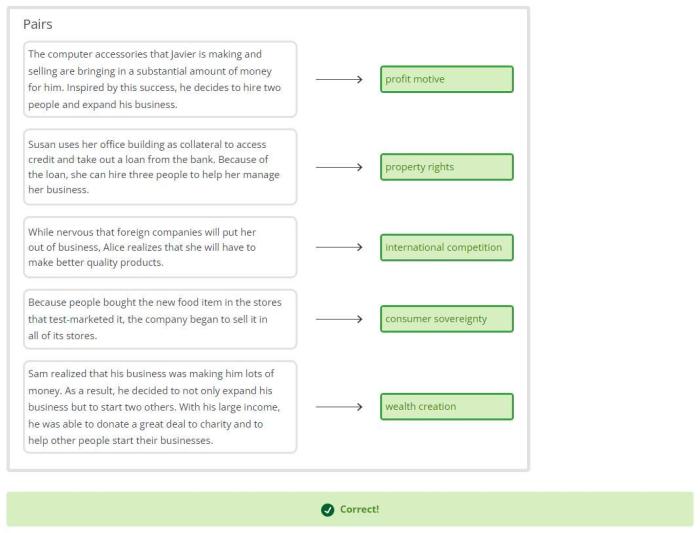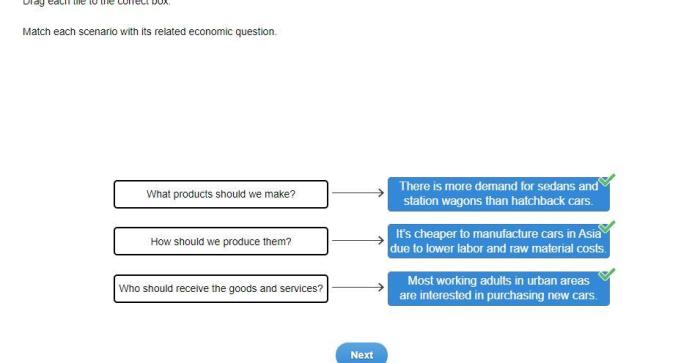Match each economic concept with the scenarios that illustrates it – Match each economic concept with the scenarios that illustrate it sets the stage for this enthralling narrative, offering readers a glimpse into a story that is rich in detail and brimming with originality from the outset. The exploration of various economic concepts and their practical applications will provide valuable insights into the intricate workings of the global economy.
As we delve deeper into the content, we will encounter a diverse range of economic concepts, including demand-side economics, supply-side economics, monetary policy, fiscal policy, inflation, unemployment, and economic growth. Each concept will be thoroughly examined, providing a comprehensive understanding of its theoretical underpinnings and real-world implications.
Demand-side Economics

Demand-side economics focuses on increasing aggregate demand to stimulate economic growth. The government can use fiscal policy to achieve this by increasing government spending or cutting taxes.
Government Spending, Match each economic concept with the scenarios that illustrates it
- Increased government spending on infrastructure, education, and healthcare can boost economic activity by creating jobs and increasing demand for goods and services.
- Example: The American Recovery and Reinvestment Act of 2009 was a large-scale government spending program that helped stimulate the US economy during the Great Recession.
Tax Cuts
- Tax cuts can increase disposable income for households and businesses, leading to increased spending and investment.
- Example: The Tax Cuts and Jobs Act of 2017 was a major tax cut that aimed to stimulate economic growth in the United States.
Demand-side economics can be effective in boosting economic growth in the short term, but it also carries risks such as increased government debt and inflation.
Supply-side Economics

Supply-side economics differs from demand-side economics by focusing on increasing the supply of goods and services in the economy. This can be achieved through tax cuts, deregulation, and other policies that encourage investment and productivity.
Key Principles
- Tax Cuts:Tax cuts can incentivize businesses to invest and expand, leading to increased production and job creation.
- Deregulation:Reducing government regulations can lower costs for businesses and make it easier for them to operate, leading to increased efficiency and innovation.
Examples
- United States:The Reaganomics policies of the 1980s implemented tax cuts and deregulation, leading to a period of economic growth.
- United Kingdom:The Thatcher government’s economic policies in the 1980s included privatization, deregulation, and tax cuts, resulting in increased competition and productivity.
Supply-side economics can lead to long-term economic growth, but it may also result in increased inequality and reduced government revenue.
Monetary Policy

Monetary policy is used by the central bank to control the money supply and influence economic activity. The central bank can use various tools to implement monetary policy, such as interest rates and quantitative easing.
Interest Rates
- Lowering interest rates:This makes borrowing cheaper, encouraging businesses to invest and consumers to spend, leading to increased economic growth.
- Raising interest rates:This makes borrowing more expensive, discouraging spending and investment, and helping to control inflation.
Quantitative Easing
- Purchasing assets:The central bank can purchase government bonds or other assets to increase the money supply, stimulating economic activity.
Examples
- Federal Reserve:The US Federal Reserve lowered interest rates to near zero during the 2008 financial crisis to stimulate economic recovery.
- Bank of England:The Bank of England implemented quantitative easing measures after the 2008 financial crisis to increase the money supply and boost economic growth.
Monetary policy can be effective in managing economic fluctuations, but it also carries risks such as inflation and asset bubbles.
Key Questions Answered: Match Each Economic Concept With The Scenarios That Illustrates It
What is the difference between demand-side economics and supply-side economics?
Demand-side economics focuses on increasing aggregate demand to stimulate economic growth, while supply-side economics focuses on increasing the productive capacity of an economy to boost economic growth.
How does monetary policy influence economic activity?
Monetary policy influences economic activity by controlling the money supply. By adjusting interest rates and implementing quantitative easing, the central bank can influence borrowing costs, investment, and consumer spending.
What are the main causes of inflation?
The main causes of inflation are demand-pull inflation, which occurs when there is an increase in aggregate demand, and cost-push inflation, which occurs when there is an increase in production costs.